I am new in the using of DevExpress. I need to design and bind a complex DataGrid.
I have designed it using the Designer. The datagrid is of type Master-Detail, and it contains the 'MainGrid' and other detail grids. One of them is of type: 'advBandedGridView'
The design of the MainGrid is as shown below:

And the design of the 'advBandedGridView' is as follows:

Now, I need to fill my DataGrid using Lists collections, so I used the following Code:
using System;
using System.Collections.Generic;
using System.ComponentModel;
using System.Data;
using System.Drawing;
using System.Linq;
using System.Text;
using System.Windows.Forms;
using System.Collections;
namespace WindowsFormsApplication2
{
public partial class Form1 : Form
{
public Form1()
{
InitializeComponent();
}
private void simpleButton1_Click(object sender, EventArgs e)
{
ArrayList a = new ArrayList();
Term_Space_Grid t = new Term_Space_Grid("x", "y", true, "z");
t.expansions = new List<MyExpansions>();
t.expansions.Add(new MyExpansions(0, "Aya", 0, 0, 0, 0, 0));
a.Add(t);
resultsGridControl.DataSource = a;
}
}
public class Term_Space_Grid
{
public string x { get; set; }
public string y { get; set; }
public string g { get; set; }
public bool z { get; set; }
public List<MyExpansions> expansions { get; set; }
public Term_Space_Grid(string x, string y, bool z, string g)
{
this.x = x;
this.y = y;
this.z = z;
this.g = g;
}
}
public class MyExpansions
{
public Morphos morphos { get; set; }
public Semantics semantics { get; set; }
public MyExpansions(int morphoID, string morphoDerivation, int synID, int subID, int supID, int hasID, int insID)
{
this.morphos = new Morphos(morphoID, morphoDerivation);
this.semantics = new Semantics(synID, subID, supID, hasID, insID);
}
}
public class Morphos
{
//public List<Morph> morph{ get; set; }
public Morph morph { get; set; }
public Morphos(int morphoID, string morphoDerivation)
{
//this.morph = new List<Morph>();
//this.morph.Add(new Morph(morphoID, morphoDerivation));
this.morph = new Morph(morphoID, morphoDerivation);
}
}
public class Semantics
{
public List<Sem> synonyms { get; set; }
public List<Sem> subClasses { get; set; }
public List<Sem> superClasses { get; set; }
public List<Sem> hasInstances { get; set; }
public List<Sem> instanceOf { get; set; }
public Semantics(int id1,int id2, int id3, int id4, int id5 )
{
this.synonyms = new List<Sem>();
this.subClasses = new List<Sem>();
this.superClasses = new List<Sem>();
this.hasInstances = new List<Sem>();
this.instanceOf = new List<Sem>();
this.synonyms.Add(new Sem(id1));
this.subClasses.Add(new Sem(id2));
this.superClasses.Add(new Sem(id3));
this.hasInstances.Add(new Sem(id4));
this.instanceOf.Add(new Sem(id5));
}
}
public class Morph
{
public int MorphoID { get; set; }
public string MorphoDerivation { get; set; }
public Morph(int morphoID, string morphoDerivation)
{
this.MorphoID = morphoID;
this.MorphoDerivation = morphoDerivation;
}
}
public class Sem
{
public int SemID { get; set; }
//public string MorphoDerivation { get; set; }
public Sem(int semID)
{
this.SemID = semID;
}
}
}
However, I found that the result is built as a new DataGrid that has not any designed form. I mean that the detail tabs that I define in the Designer are not appeared in the resulted grid.
The result is as follows:

Notes
- The design of the resulted grid which is totally different from my design, I think it is just like the Lists objects.
- The other problem which is the appearance of : "WindowsFormsApplication2.Morphos" and "WindowsFormsApplication2.Semantics" at the cells of the grid rather than the values that I passed!